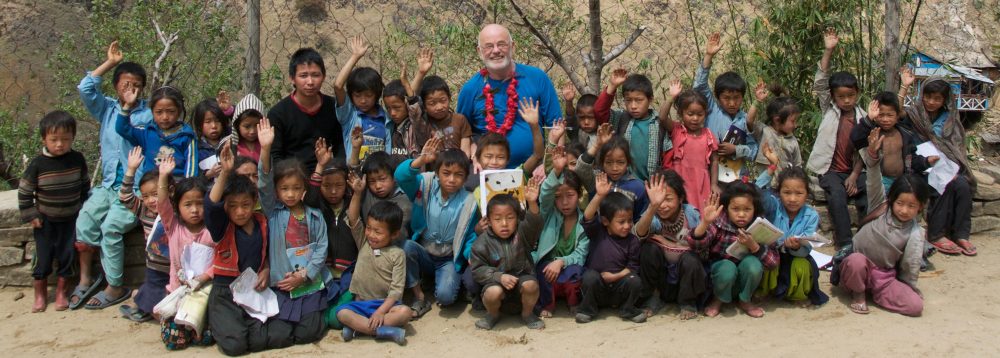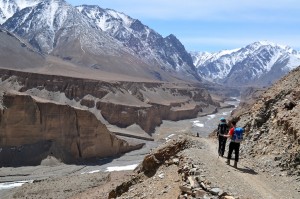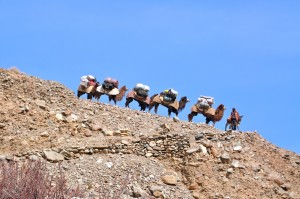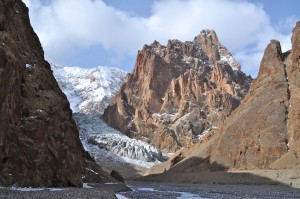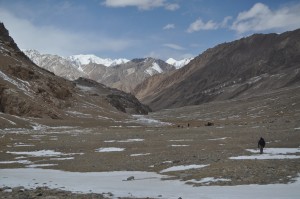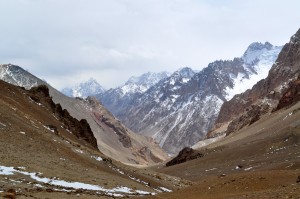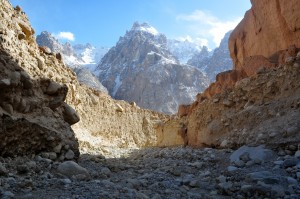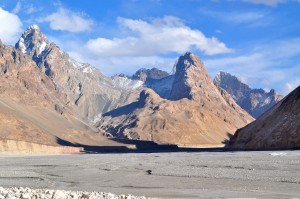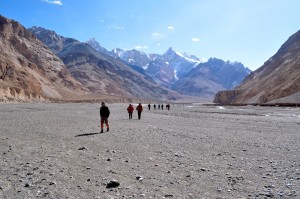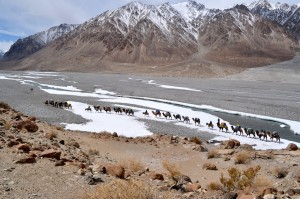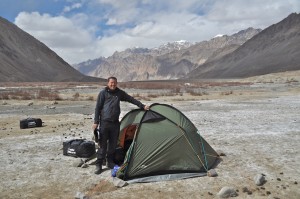Our first day of trek got off to a very slow start. We were ready by 8.00 but the crew, and the camels in particular, were not. To save us hanging around we wandered into the village and then headed in the right general direction to a group of stones, which provided us with seats in the sun. Akbar, Hira and Bishnu finally joined us at about 10.30 and we properly started our trek.
Despite the fact that it was a good path and any gradients were easy it was still a bit of a struggle. First days often are and after a week of travelling, walking at 3500m is always going to be difficult. Having come over the shoulder at the end of a ridge separating the valley with Yilik and the Yarkand River, the walk became more interesting, especially when we dropped down to the river for lunch. The river cut valley is fabulous with a braided river on the flat bed with steep cliffs on either side. Looking up towards the head of the valley there were beautiful snowcapped peaks.
Another point of interest lay on the river bed where there were huge lumps of jade. One rock, Hira estimated, would be worth about a £1,000,000! Having found one we found lots. It is hard to imagine that the Chinese have not taken advantage of such a treasure at their feet. Soon after lunch we reached camp situated in a beautiful part of the valley and bathed in glorious sunshine.
The following morning we continued up the gorge with spectacular cliffs on either side and hardly any sign of vegetation. As the path, at times, was very close to the fragile cliffs, we kept a wary eye on them in case any rocks chose to dislodge themselves as we passed beneath. We stopped for lunch where the river cut through a narrow cleft in the rock and where we had to leave the river bed and negotiate our way across the cliffs before descending to the riverbed again. It made a nice change from picking our way over the stones of the river bed, which you constantly had to watch to make sure you put your foot down safely. The stones were so varied, and many were beautiful works of art.
It is very difficult to judge distances in this environment. We can see our target along the valley, or the next bend or rocky outcrop, but it takes ages to reach. In places the valley, river floor, may be a mile or more across with mountains rising vertically on either side for several thousand feet.
By mid afternoon tiredness was beginning to set in with the feet suffering most from continually being pummelled by stones. Simon was struggling and Rachel had taken to riding one of the donkeys. We eventually arrived in camp, a summer grazing area for sheep and goats. Now there was no grass to be seen and the area was covered in pellets from last year’s flocks. It was also very windy and not the most pleasant place to pitch a tent. We were also warned not to pitch too close to the valley edge because of potential rock fall. During the evening the loo tent blew away, leaving us with only the alfresco version for the rest of the trek.
Later that evening the wind died down and we had a peaceful night but as soon as it got light the wind picked up again and the wind chill made it extremely cold. Rather than wait around in camp and get cold we decided to set off without the crew, some of us taking the slight detour to have a look at a nearby glacier with an impressive snout. This required us to cross the river which was fortunately frozen at this point.
Having visited the glacier we set about the task of climbing and crossing the Aghil Pass. It was expected that it would take us about five hours to reach the top. With the wind blowing fiercely in our faces it actually took about five and a half hours. By the time I reached the top I was feeling exhausted. The wind had made my eyes run and my tears had frozen on my cheeks. It was stunningly beautiful with rocky, snowy mountains to either side. We alternated between walking on stony paths and snowfields. On one of the snowfields we came across the paw prints of snow leopards, two adults and a young one.
I had hoped to have lunch on the top and admire the view. It gave a superb panoramic view of the Karakorum mountains to the south with Gasherbrum 2 and 3 being the most spectacular. Unfortunately it was too windy and there was nowhere to shelter. It was disappointing that the conditions did not allow for us to linger and make the most of the situation. Instead, we focused our attention on getting down out of the wind. Going downhill I suddenly found renewed energy and soon found a sheltered spot for lunch.
The path down was good and as I was walking on my own I was able to make good progress . However the lower I got the more complicated it became. There was no sign of a clear path and it was simply a case of picking my way through a boulder field. Eventually, I had a choice to make. The river bed descended into a gorge with steep cliffs on either side. Should I follow that or stay above it? Akbar suddenly showed up and directed me into the gorge as it was a short cut avoiding a three hour detour, which the camels had to make. The river bed in the gorge was strewn with huge boulders and the cliffs looked very dangerous with rocks defying gravity and clinging to the loose material in between. Sometimes we had to scramble down dry waterfalls, making our descent more interesting. All the time we could hear rock falls on the slopes above and it felt it was only a matter of time before boulders came crashing down into the gorge. I felt a little annoyed that we were being subjected to this towards the end of a long day when everyone was tired and, therefore, more likely to make a mistake.
Eventually we emerged from the gorge into the magnificent Shagskam River valley, with mountains towering above. Here the river was about a mile across and it seemed to take ages to pick our way across it to our camp on the other side. It was a super spot for camping among some low bushes with a spring emerging from the rock wall adjacent to the camp. Over dinner we discussed the merits of having a rest day or continuing to base camp. The weather continues to be very good and seemed settled so we decided to continue and make the most of it before it decides to break and turn nasty on us.
The next day was spent entirely walking along the Shagskam river bed across a mixture of stones and large areas of frozen river. It was much easier walking on the ice as the stones again proved very tiring on the feet. It seemed to go on for ever and while we were walking we had to concentrate on our feet and not take in the beautiful scenery around us. It was very dispiriting to not appear to make any progress. At one point in the morning we had to de-boot in order to cross the river. We all had water shoes in our kitbags but Akbar had told us in the morning that we would not need them today. The water was extremely cold as it was flanked on either side by snow and ice. Negotiating the pebbles without shoes protracted the crossing.
By lunch time we had only covered half the distance to camp. Those of us who were the first to leave after lunch were instructed, for some inexplicable reason, to climb above the river and drop into a gorge to avoid the river close to the left bank. Obediently, we followed instructions only to find Akbar and the rest of the group following by the water’s edge. The bonus for us was that we saw some fantastic fossils.
We reached camp late in the afternoon and pitched our tents in the strong breeze, which seems to be a feature of each afternoon.
During the evening I had discussions with Hira, Akbar and the camel men about what we might achieve on the glacier. Hira was very optimistic and determined while Akbar seemed less enthusiastic. It turns out he has never been above Italian Base Camp because he has not encouraged it and groups have turned back. The truth of it seems to be that Akbar does not like the cold and does not fair well at altitude so he encourages groups to turn back at the first opportunity.
The next morning we continued along the river to the junction with the Sarpo Largo River where we climbed up on to a shoulder above the river for our first view of K2. By the time we got to the viewpoint the cloud had begun to build up and although the outline was visible it was not very clear. The mountains around it were pretty spectacular but K2 stood out head and shoulders above them.
Dropping back down to the river we continued towards Chinese Base Camp, stopping for lunch on the way. After lunch we had a further three hours of sole destroying trudge into camp. Along the way we had to cross the frozen K2 River, the most dangerous to cross in the summer when the waters thunder off the glaciers above. On the frozen river lay the corpse of a Kiang, a wild ass, which had fallen victim to a snow leopard, the stomach and the heart being the only meat taken.
Chinese Base Camp, at 3900m, proved to be a very cold place at night and it was necessary to wear my down jacket for dinner. Taking ourselves off to bed fairly early we were woken at 9.45pm by a stampede of camels through the camp. It was all to do with sex! As they ran at full tilt through the tents, the guy ropes were ripped out. The crew were called to deal with the rampant animals and it took them a while to round them up and lead them well away from camp. Those who witnessed the camels said that they were jumping over bushes and could easily have jumped over the tents, which they looked upon more as rocks to run round. It was quite worrying for them, less so for those of us who remained in our tents.
The next day was a rest day, a day for washing body and clothes, sorting kit to take on to the glacier and relaxing in the glorious sunshine. Bliss!
The food on this trek has been amazing and some of the best and tastiest I have had on any trek. We do not miss the cooked lunch, nor the puddings in the evening. It was such a relief after the concerns we had before we left home. All the extra provisions we brought out with us, comfort treats, soups and pasta sachets were all unnecessary.
Trekking up to Chinese Base Camp has been fantastic and one of the things, I think, that makes it a bit special is the remoteness of it. When Shipton explored this area he wrote the book, ‘Blank on the Map’. That is exactly what this is. There are no villages, no people; we were the only ones there with nobody else in the world within at least 35 miles in any direction.
On the afternoon of our rest day, John Leeson took himself for a walk in the direction of Pakistan Base Camp in the hope of meeting Hira and Bishnu returning from their recce on the glacier. Just before they met, John needed the privacy of a rock for a few minutes. Hira, on approaching the rock, spotted two snow leopards about 200m below where John was. By the time John had pulled up his trousers, the snow leopards were gone and he missed them!
That night we held a quiz in the mess tent with Charles as the compiler of the questions and quiz master. We all had to dress for the evening, the theme being ‘the boat club’. I simply wore a bow tie but others went to great lengths to dress up for the occasion. David acquired some cardboard from the kitchen tent and made himself a boater, as did Chris using reeds from the river bank, but Charles went one stage further turning his silk liner into a 1920s style dress with flexible boobs. We had a great evening, even if we found the questions hard. The brain does not function very well at altitude.
